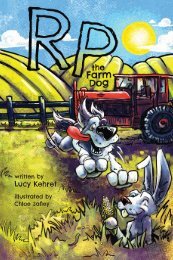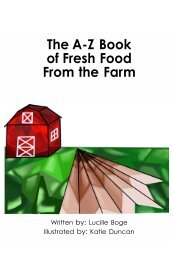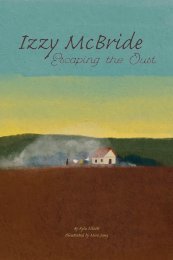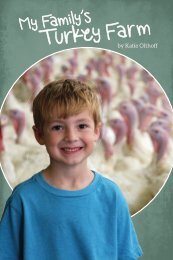My Family's Beef Farm
Meet Cecelia, a 10-year-old farm girl in Iowa. Cecelia and her family live on a beef cattle farm. Learn how farmers care for cattle and raise safe, nutritious beef through Cecelia's eyes, as she takes you on a tour of her family's beef farm.
Meet Cecelia, a 10-year-old farm girl in Iowa. Cecelia and her family live on a beef cattle farm. Learn how farmers care for cattle and raise safe, nutritious beef through Cecelia's eyes, as she takes you on a tour of her family's beef farm.
You also want an ePaper? Increase the reach of your titles
YUMPU automatically turns print PDFs into web optimized ePapers that Google loves.
by Katie Olthoff
by Katie Olthoff
My Family’s Beef Farm
Written by Katie Olthoff
Photographed by Jenn Hindman
Printed in collaboration with:
Iowa Agriculture Literacy Foundation
Iowa Beef Industry Council
Iowa Agriculture
Literacy Foundation
R
Hi! I’m Cecelia.
This is my mom,
dad, brother
and sister. We
live and work
together on our
family’s farm.
The Rowe family lives in central Iowa. Tanner is a farmer and Laura works for
an agriculture company. Cecelia is 10 years old, Ben is 8 and Adeline is 6.
About one million farmers and ranchers in the U.S. raise cattle.
2
3
Our farm in 1914
Farmers grow food. They also work hard to
care for the land and livestock.
On our farm, we raise corn, soybeans, and
beef cattle. We also have a dog, three ponies
and two horses.
Cattle are important to my family. My great,
great, great grandpa was a farmer. He taught
my great, great grandpa how to care for the
land and animals. Then my great, great grandpa
taught my great grandpa, who taught Grandpa
Glenn. Grandpa Glenn taught my dad. My dad
is teaching my brother, sister and me.
Grandpa Glenn with HIS grandpa in the mid-1950s, on the same place where I live!
Iowa is home to more than 26,000 cattle farms. 97% of the farms in the U.S. are
family farms like Cecelia’s.
Livestock: farm animals, including cattle, hogs, sheep, goats, poultry, and
others
Companion animals: pets like dogs, cats, ponies and horses
The Rowe family settled in Iowa in the 1860s. They raised a variety of crops
and livestock.
Over the years, many farmers in Iowa began specializing in one type of
livestock. Since the turn of the century, the Rowe family’s farm has focused
on cattle.
4
5
Some of our cattle are born on my
grandpa’s cow-calf farm. He has 100
momma cows who live out here on pasture.
There is plenty of fresh grass for all the
cattle to eat and water for them to drink.
Every year, the cows have a baby,
called a calf.
The calves are born on the pasture.
Pasture: a grassy, fenced-in field where livestock like cattle can eat and live
Pastures help prevent erosion. The roots from the grass hold soil in place on
hilly land.
Calf: a cow’s baby
Most of the time, calves are born on their own, but when the farmer is expecting
calves, he checks on his cows every two to three hours, even in the night.
6
7
A new calf weighs about 70 pounds. It
can walk just 1 hour after it is born. The
calf stays with its mom for about
6 months, drinking her milk and learning
to eat grass.
Grandpa moves the cows
and calves from one part
of the pasture to another
about once a week. This
way, they can have fresh
grass to eat.
He also checks on
them several times a
week to make sure
they are healthy.
Farmers want to use the land efficiently, growing as much food as possible with
the land that is available.
Rotational grazing: moving the cows frequently to different paddocks of grass,
one way farmers use the land carefully to grow a lot of food
Farmers and ranchers make continuous improvements to protect the
environment. Modern beef farms are more efficient, requiring less water, land
and energy.
8
An average calf weighs 70 pounds at birth.
An average 3 rd grader weighs 50 to 60 pounds!
50 lb 70 lb
9
When the calves
are about 6
months old,
they begin
eating more
grass and grain.
Cattle eat grass
for most of their
lives. People can’t
eat grass but
cattle can. They
eat food that we
can’t eat, then
turn it into yummy
beef or milk!
10
These cattle are beef cattle, raised for their meat. Other breeds are dairy cattle,
raised mostly for milk, but also for beef.
There are many different breeds of cattle. Each breed has distinct characteristics,
including different colors of hair. Some are bigger, some are smaller, some are
better for warmer climates and some are better for cooler climates.
There are more than 70 different breeds of cattle in the U.S.
Ruminants: animals that can eat grass
including cattle, goats and sheep
Ruminants have four compartments
in their stomach that help them digest
the grass.
11
Pasture
Feedyard
Cattle Barn
There are many
different ways to
raise cattle.
Some cattle live
on pasture for
their whole lives.
Other cattle move
to feedyards.
There, they live in
open lots or barns.
When grandpa’s
calves are about
550 pounds,
they move to
the feedyard
on our farm.
No matter
where cattle
are raised, the
farmers like
my dad and
grandpa take
care of them
every day.
Farms use different housing systems depending on the climate and their
individual farms.
Sustainability: raising cattle in a way that is environmentally sound,
economically viable and socially responsible
Farmers consider sustainability when making decisions on their farms.
Farmers are dedicated to the care of their livestock. Whether it’s New Year’s
Day or the 4th of July, farmers will be working, without a day off. Even in a
blizzard or a thunderstorm, they will take care of their animals.
12
13
The cattle get vaccines to keep them healthy,
just like my brother, sister and I do. If the
cattle do get sick, Dad and Grandpa work with a
veterinarian to make them healthy again.
Every morning, we get up early to feed our
cattle. These three calves belong to my
brother, sister and me. We take special care
of them. In the
summer, we take
them to the
county fair.
But most of
our cattle live
in open yards or
these barns.
14
Show cattle are cattle that are raised for competitions at county and state fairs.
The best cattle on the farms are taken to livestock shows, where farm kids can
show off their animals and the way they care for them.
Cattle may receive antibiotics when they are sick. The antibiotics do not affect
the quality or safety of the meat.
Kids get vaccines to keep them from getting sick. So do cattle!
Veterinarian: a doctor for animals
Veterinarians monitor the cow and calf’s health. Veterinarians, or vets for
short, attend college for four years and then a college of veterinary medicine for
four more years.
15
We recycle the
cattle manure to
fertilize the fields.
Then, the fields
grow more corn
for next year.
We grow corn to feed to our cattle. They love
the corn and grow quickly when they eat it.
Dad uses a special feed recipe and mixes the
corn with other ingredients. He changes the
recipe as the cattle grow.
Why do farmers feed cattle corn?
Corn is high in energy, which helps cattle grow quickly and efficiently.
Some corn is made into ethanol (a fuel like gasoline). After the ethanol is made,
distillers grains are leftover and cattle can eat these, too.
Efficient: preventing the wasteful use of a particular resource
The floor in the barns is covered with corn stalk bedding. The cattle manure can
be scooped up and used as fertilizer on the fields.
The manure contains important nutrients that improve the soil health and make
the corn grow better.
Recycling the manure and corn stalks is another example of how farmers and
ranchers practice sustainability and efficiency.
16
17
The calves come to our farm when they are
about six months old. They stay here for
about 200 days.
Dad feeds them
once a day. He
checks on them two
more times each
day. Dad makes
sure the cattle
are healthy and
comfortable.
When the cattle
weigh about 1300
pounds, we sell
them. They are
made into beef and
other things we
use every day.
Cattle rations: A carefully balanced, nutritious diet that is developed with a
livestock nutritionist and changes as the cattle grow
Beef Quality Assurance: The Beef Quality Assurance program was created in
1987 and includes research, training and certification that helps farmers and
ranchers provide the best care for their cattle.
The handling and care of more than 90% of feedyard cattle is influenced by
this program.
More than 1000 quarter pound hamburgers can be made from a 1300 pound
steer, as well as steaks, ribs and roasts.
There are 38 cuts, or types, of lean beef. One serving of lean beef (3 ounces)
provides 10 nutrients your body needs each day, for about 150 calories.
One 3 ounce serving of beef is about the size of a deck of cards or a cell phone.
18
19
Did you know footballs
are made from cow’s hide?
And lipstick and glue have
ingredients from cattle, too!
But the best thing
that comes from
cattle is BEEF!
My brother loves
hamburgers. My
sister and I love
Sloppy Joes.
Mom and Dad love
steak with potatoes.
20
Cattle provide us with many other by-products.
By-products: parts of the cow that are not meat
By-products come from the hide, fat, bones, organs, blood and feet. They are
used to make different things for people to use.
Beef provides more than 10% of the Daily Value for 10 essential nutrients. The
nutrients in beef help you grow.
Zinc helps you think and improves your memory.
Iron carries oxygen to your blood to give you energy.
Protein makes your muscles strong.
Most of the beef you buy is considered natural, meaning it is minimally
processed and contains no additives.
21
When I grow up, I want to be a veterinarian.
I want to help care for animals. But for now,
I’m glad I live
on my family’s
beef cattle farm.
Here, I get to
help my family
take care of our
cattle every day.
22
There are many different jobs that make the beef industry successful:
Farmer: someone who cares for animals every day
Veterinarian: a doctor for animals
Animal Nutritionist: someone who develops diets to keep animals healthy and
help them grow
Animal Scientist: someone who researches the best ways to care for cattle, ways
to make food safer, and other topics 23
BEEF: meat from cattle
BEEF CATTLE: cattle raised for meat
CALF: a cow’s baby
Glossary
CATTLE RATIONS: a carefully balanced, nutritious
diet that is developed with a livestock nutritionist and
changes as the cattle grow
COMPANION ANIMALS: pets like dogs, cats, ponies and
horses
DAIRY CATTLE: cattle raised mostly for milk, but
also for meat
EFFICIENT: preventing the wasteful use of a particular
resource
FARMER: someone who grows food
LIVESTOCK: farm animals, including cattle, hogs, sheep,
goats, poultry, and others
PASTURE: a grassy, fenced in field where livestock like
cattle can eat and live
ROTATIONAL GRAZING: moving the cows frequently
to different paddocks of grass
RUMINANTS: animals that can eat grass including cattle,
goats and sheep; ruminants have four compartments in
their stomach that help them digest the grass
SUSTAINABILITY: raising cattle in a way that is
environmentally sound, economically viable and
socially responsible; farmers always consider
sustainability when making decisions on their farms.
VETERINARIAN: a doctor for animals
More Beef
By-Products
Leather
Cowhide provides us with leather, which is used to make:
• clothing
• shoes
• boots
• belts
• purses
• wallets
• gloves
• sports
equipment
• automobile
upholstery
• furniture
upholstery
Household Products
These products are partially made from cattle:
• ceramics
• crayons
• creams and
lotions
• deodorants
• detergents
• dog food
• gelatin
• glue
• insulation
• linoleum
• paper
• shaving cream
• sports
equipment
• soaps
• textiles
• medicines
24
25
Meet Cecelia, a 10-year-old farm girl in Iowa.
Cecelia and her family live on a beef cattle farm.
Learn how farmers care for cattle and raise safe, nutritious beef
through Cecelia’s eyes, as she takes you on a tour of
her family’s beef farm.
ADDITIONAL RESOURCES:
www.iabeef.org
www.iowaagliteracy.org

















